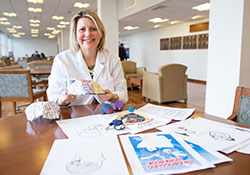

Hands-on Science
Sparking an Elementary Interest in Science
When the school year ends this June, a group of kindergarteners at P.S. 3, in Jersey City, NJ, will leave their classrooms with a good idea of what’s inside their brains. This March, Dr. Robin Green, an assistant professor of neurology whose son attends school in Jersey City, plans to visit the youngsters during Brain Awareness Week. The program is based on a successful pilot she launched last spring at the elementary school. She partnered with the Dana Alliance for Brain Initiatives to put together an interactive program that included lessons about the brain’s two hemispheres, how the brain works and how it is protected by the skull and cerebral spinal fluid.

Robin Green, Psy.D., poses with teaching materials she uses during her Brain Awareness Week visits to P.S. 3 in Jersey City, NJ“I’ve seen firsthand how little hands-on science is done in the classroom prior to third grade, largely due to lack of funding, and I wanted to bring this kind of experiential learning into an urban setting,” explained Dr. Green. “I wanted them to see that you don't need fancy equipment to learn or to take part in science.”
She added, “I decided to participate in the alliance’s global campaign to promote public interest in the brain and neuroscience research because it offered a great way to reach young children and introduce them to STEM concepts that typically won’t be taught to them until later in grade school. I wasn’t encouraged to study science as a child, and I believe it’s important that we spark that interest as early as we can.” (STEM stands for Science, Technology, Engineering and Mathematics.)
Dr. Green trained in neuropsychology, with a specific focus on traumatic brain injury and prevention of concussion and sports injury, in children and in professional athletes. “Putting together the Brain Awareness Week program provided me the perfect opportunity to teach about a subject I’m passionate about, imparting useful information to Jersey City school children,” she said.
During Dr. Green’s program, the youngsters participated in experiments and a variety of other interactive activities. They viewed pictures and models of what real brains look like and did exercises involving the five senses and how to protect their brains from injury.
“It was so educational and exciting,” noted Natasha Caicedo, lead kindergarten teacher for the group. “We all had a great time learning.”
Dr. Green’s return to P.S. 3 this school year stems from the positive feedback she received from teachers, parents and the first group of kindergarteners she met with last March..
“Most thrilling to me was the young girl who told her mother that she wants to grow up to be a brain doctor,” recalled Dr. Green. “I hope to inspire other youngsters like her to be excited about science, whether or not they pursue a career. And I’m thinking about how I might reach out to middle and high school volunteers, who could assist me with the experiments and activities.”
Posted on: Friday, March 11, 2016

Tablet Blog